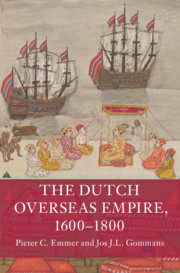Book contents
- The Dutch Overseas Empire, 1600–1800
- Additional material
- The Dutch Overseas Empire, 1600–1800
- Copyright page
- Contents
- Figures
- Cover Image
- Maps
- Note on Terminology
- Preface
- Frontispiece
- Introduction
- Part I The Grumbling Hive
- Part II The Atlantic World
- Introduction
- 4 The Caribbean
- 5 New Holland and New Netherland
- 6 Africa
- Conclusion
- Part III Monsoon Asia
- Coda
- References
- Index
4 - The Caribbean
from Part II - The Atlantic World
Published online by Cambridge University Press: 29 September 2020
- The Dutch Overseas Empire, 1600–1800
- Additional material
- The Dutch Overseas Empire, 1600–1800
- Copyright page
- Contents
- Figures
- Cover Image
- Maps
- Note on Terminology
- Preface
- Frontispiece
- Introduction
- Part I The Grumbling Hive
- Part II The Atlantic World
- Introduction
- 4 The Caribbean
- 5 New Holland and New Netherland
- 6 Africa
- Conclusion
- Part III Monsoon Asia
- Coda
- References
- Index
Summary
The Dutch traded with all of the other Atlantic empires in spite of the increasingly protectionist policies. That is why the Dutch activities in the Atlantic consisted for the most part of trade and that is why the Dutch presence in that region has been labelled as ‘expansion without empire’. This chapter, however, tells the story of the Dutch colonial expansion in the Caribbean in a comparative perspective. Here the Dutch founded several plantation colonies in addition to conquering several small islands that were used for the transit trade. Much of this chapter is devoted to the Dutch participation in the Atlantic slave trade. The Dutch might have been the first to introduce that trade in the Middle and North Atlantic; they were unable to oust the Portuguese in the South Atlantic. Very quickly the Dutch encountered strong competition from English and French slavers, and in about 1700 the Dutch slave trade concentrated more and more on selling slaves in the Dutch colonies in the Caribbean. Only during the periods of war were the Dutch able to resume their role as neutral suppliers of slaves, particularly to the French West Indies.
- Type
- Chapter
- Information
- The Dutch Overseas Empire, 1600–1800 , pp. 144 - 183Publisher: Cambridge University PressPrint publication year: 2020

